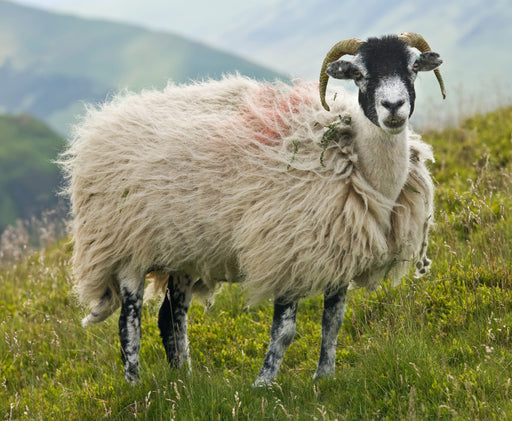Caring for Woolen Clothes
 User:Diliff, CC BY-SA 3.0, via Wikimedia Commons
User:Diliff, CC BY-SA 3.0, via Wikimedia Commons
Extend the life of your wool clothing and blankets, and deter damaging clothes moths larvae by following this great advice.
Wool is the natural fiber obtained from sheep and a few other animals, including mohair from goats and angora from rabbits.
The scaling and crimp in wool make it easy to spin into yarn by assisting the individual fibers in attaching to each other during the spinning process. The crimp gives woolen fabrics a higher bulk than other textiles, and it retains air, which allows the product to retain heat. Wool fibers are hollow which enables them to readily retain more moisture than other garment fibers.
This increased level of warmth and moisture is an attraction to moths.
Washing Woolen Clothing and Blankets
Always check the manufacturer’s care label to ascertain whether your wool garment is suitable for hand washing, machine washing or dry cleaning only. It is recommended that woolen clothing is washed after every 4 or 5 wearings and cashmere more often.
Hand Washing Wool
Most woolen garments and blankets require hand washing, although be sure to check your permanent care label to see whether the item is ‘dry clean only’. Use a mild detergent or a specialist woolen laundry liquid.
Agitate the detergent and ensure the clothing is thoroughly exposed to the solution through gently squeezing it through the washing stage. Loss of dyes at this stage may occur, especially in new garments, until the item has been washed a few times and the excess dye removed. Do not be overly rough in the wash to avoid distorting the shape of wool clothes. Rinse several times in cool to lukewarm water to ensure the detergent is fully removed before the drying stage.
To dry, it is recommended that woolen clothing is rolled in a towel and gently pressed to remove initial quantities of water before then laying flat and shaping on a clean towel to dry fully. Woolen clothes should hold their shape well because of the natural elasticity in the fibers. Avoid direct heat and do not use a tumble dryer.
Machine Washing Wool
Only ever machine wash a woolen garment if explicitly stated in the permanent care label of woolen clothes. Some woolen garments have fibers coated in a resin that prevents them becoming interwoven more tightly in the washing process (which would result in a loss of softness in the garment). Try to avoid detergents that are described as biological or containing brightening agents. The wash temperature should be 30 or 40 degrees and the spin cycle should be kept slow and short in duration.
For drying, follow the care advice for hand washing above.
Dry Cleaning Wool
Use a reputable dry cleaner that you have experience of or comes highly recommended. Many woolen garment care labels will specify ‘dry clean only’, in which case please do not attempt to hand or machine wash. The dry cleaning solvents and process also eradicate any moth eggs or larvae that may be present on wool clothing. Woolen blankets are always best dry cleaned – hand or machine washing can result in significant shrinkage and a loss of softness in the feel of the blanket.
Stain Removal
It is always best to use a good specialist dry cleaner to remove severe stains or marks on wool clothing.
When taking your garment to the dry cleaner for stain removal, try to do so quickly and explain exactly what the stain has been caused by to increase the chances of success in wool stain removal.
Pressing: You may not need to iron or can reduce the amount of ironing required by hanging your woolen clothing whilst still slightly damp (not wet!). If you do need to iron woolen garments, use a low / wool temperature setting on your iron. Always do the main ironing with the clothes inside-out. Where you need to iron the ‘right-side’ of the fabric, always iron through a clean white cloth, to avoid resulting a ‘shiny’ effect. Steaming is an effective way to remove creases without the risks associated with ironing!
Storage and Clothes Moth Prevention for Woolen Clothes and Blankets
Wool garments should be stored clean – this is critical because clothes moth larvae feed on human and animal hair and skin which is a form of protein, and they are also particularly attracted by food stains and the residual from perspiration, which also provides the moisture that is essential to their survival. Wool itself, being made from animal hair, is made of keratin, a form of protein that is a foodstuff for moth larvae.
We recommend that wool clothes are stored neatly folded, and ideally in storage bags. Before storing, we recommend you lightly brush woolen garments with a soft clothes brush.
If you are storing your woolen clothing or blankets for a long period we recommend that you periodically shake the items and air in bright light to deter any potential moth larvae settling. They hate disturbance and light! Vacuuming cupboards and closets at this stage is also really important.
At Moth-Prevention.com we provide a number of solutions to both eradicate moths and their larvae, as well as prevent further moth damage to your clothing.
To monitor for Clothes Moths we recommend the purchase of our Clothes Moth Traps for Wool Moths which will help break the breeding cycle by attracting the adult male moths. For a larger infestation you may like to read our Clothes Moth Kit Guide for information on how to use chemical products in line with our Traps to rid your home of Clothes Moths.
FAQs for Caring for Woolen Clothes
If you are taking the steps to protect wool from moths, there’s a good chance you care about your clothes made of this material. When caring for woolen garments, there are a few special considerations to keep in mind. Here are some helpful FAQs on how to clean and care for woolen clothes!
How do you take care of a wool sweater?
There are many aspects to wool care. Understanding how the fabric must be stored, washed, and treated will help to ensure your favorite cozy wool sweater will last longer. So how is wool washed? Can you iron wool? To take care of a wool sweater, you will need to know how to wash it properly with the right detergent. Also, you need to know how to treat wool when it comes to heat and how to store your wool sweaters so they are protected from Clothes Moths.
Although wool can be ironed, you need to take extra care. After all, very hot temperatures can affect this natural fabric. When ironing wool, use a piece of muslin or cotton to protect it from direct clothes iron heat. Also, do not put wool clothes in the dryer on a high heat cycle. Moreover, you should wash wool with wool-safe detergent (like Woolite) and set your washer to the "wool" setting, which is gentle and at the correct temperature. Finally, take care to protect wool from Clothes Moths.
How do you wash wool without ruining it?
Can you wash wool? The answer is yes. However, wool is sensitive to water, heat, and stretching. After all, it is made from natural fibers, usually sheep, but sometimes also alpacas or other animals! So, be careful and don’t use harsh soaps or very hot water. Wool can not go through a clothes dryer on “hot” as the garment may shrink. It is also best for wool to be air dried flat to stop it from stretching.
So can you machine wash wool? Yes, you can wash wool in a washing machine. To wash wool, first turn the woolen garment inside out (if possible). Next, add a wool-safe detergent to the “wool” wash cycle. If your washer doesn’t have a wool cycle, wash wool with cool or slightly warm water on a gentle cycle. Afterward, allow your wool garment to air dry ideally flat on a clothes drying rack so as to avoid stretching. High heat can ruin wool.
Is wool easy to maintain?
Wool is sustainable and versatile. It has long wear as well and is very hardy! Bearing that in mind, yes, it is easy to maintain. Though, wool can be sensitive to heat. Especially if it is woven loosely. To avoid shrinkage, keep wet wool away from high heat sources like clothes dryers.
About MothPrevention
MothPrevention® speak to customers every day about their clothes moth issues - clothes moths are a species that are ever increasing and that can cause significant damage to clothes, carpets and other home textiles.
To date, we’ve helped over 250,000 customers deal with their moth problems. We have developed professional grade solutions including proprietary pheromones and trap design, not available from anybody else in the USA.





